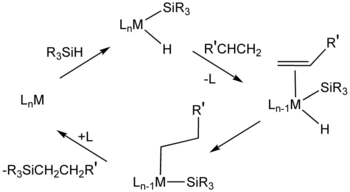Hydrosilylation, also called catalytic hydrosilation, describes the addition of Si-H bonds across unsaturated bonds. Ordinarily the reaction is conducted catalytically and usually the substrates are unsaturated organic compounds. Alkenes and alkynes give alkyl and vinyl silanes; aldehydes and ketones give silyl ethers. Hydrosilylation has been called the "most important application of platinum in homogeneous catalysis."
Hydrosilylation of alkenes represents a commercially important method for preparing organosilicon compounds. The process is mechanistically similar to the hydrogenation of alkenes. In fact, similar catalysts are sometimes employed for the two catalytic processes.
The prevalent mechanism, called the Chalk-Harrod mechanism, assumes an intermediate metal complex that contains a hydride, a silyl ligand (R3Si), and the alkene substrate. Oxidative addition proceeds by the intermediacy of a sigma-complex, wherein the Si-H bond is not fully broken.

Hydrosilylation of alkenes usually proceeds via anti-Markovnikov addition, i.e., silicon is placed at the terminal carbon when hydrosilylating a terminal alkene。Variations of the Chalk-Harrod mechanism exist. Some cases involve insertion of alkene into M-Si bond followed by reductive elimination, the opposite of the sequence in the Chalk-Harrod mechanism. In certain cases, hydrosilylation results in vinyl or allylic silanes resulting from beta-hydride elimination.
Alkynes also undergo hydrosilylation, e.g., the addition of triethylsilane to diphenylacetylene:
- Et3SiH + PhC≡CPh → Et3Si(Ph)C=CH(Ph)




